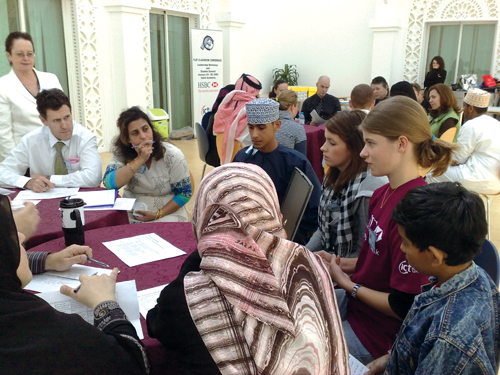 Australian Julie Lindsay has been the E-Learning Coordinator at BISS since 2009. A 13-year expat, she has taught in Qatar, Zambia, Kuwait and Bangladesh. In fact, it was her many overseas experiences that lead her to co-founding the Flat Classroom Conference, a unique event for students and educators that aims to create global connections in the classroom via technology. The second of these conferences takes place in Beijing in February, featuring participants from across the spectrum of Beijing’s international schools, as well as local Chinese schools and visitors from over ten countries. In the busy lead-up to the conference, we talked to Lindsay to find out how technology is shaping our schools.
Australian Julie Lindsay has been the E-Learning Coordinator at BISS since 2009. A 13-year expat, she has taught in Qatar, Zambia, Kuwait and Bangladesh. In fact, it was her many overseas experiences that lead her to co-founding the Flat Classroom Conference, a unique event for students and educators that aims to create global connections in the classroom via technology. The second of these conferences takes place in Beijing in February, featuring participants from across the spectrum of Beijing’s international schools, as well as local Chinese schools and visitors from over ten countries. In the busy lead-up to the conference, we talked to Lindsay to find out how technology is shaping our schools.
In a nutshell, what is the Flat Classroom Conference? It’s a gathering of educators and students, with the purpose of envisioning the future of education while using emerging technologies to connect, communicate, collaborate and create products that can be used in the future to join communities and classrooms.
And what happens over the course of the three days? In addition to developing skills with Web 2.0 and instructional design for global collaboration, participants will work in teams through a process of pitching ideas, refining and finally creating multimedia artifacts to share with others. Virtual participants connect via platforms such as wikis, blogs, live streaming and chat facilities.
What do you expect attendees to walk away with?
Educators will leave the conference understanding how to connect, communicate and collaborate globally, and with skills and contacts in hand to start projects. Students will leave the conference with leadership skills, technology skills, presentation skills, and a better understanding of diverse cultures and collaboration.
What was your original inspiration for starting this conference?
Our motivation was to bring together people who wanted to learn about how to ‘flatten’ their world for learning – in other words, how to collaborate successfully with others online, successfully design or complete a global collaborative project. We knew our online projects were producing amazing ideas and influencing pedagogy and changing lives. We wondered how powerful actually being face-to-face for a few days could be for students and educators.
What was your schooling like when you grew up, technology wise?
[Laughs] Well as a high school graduate from the 70s, school was very low tech! We had mobile nothing, except maybe a cassette player. I don’t remember one computer at school, ever!
When I was a teen, I was teaching my parents how to program their VCRs. Now, my daughter is teaching me how to use my iPhone. How do you keep up with your students?
I don’t! I also do not feel the compulsion to keep pace. I have a teenage daughter who teaches me a lot all the time. At the same time, I teach her a lot about how to use the technology professionally, not just socially. I don’t believe that having digital fluency is ageist. We have many older teachers who are adopting and adapting technology for education. In many respects, there is a terrible gap with current teacher colleges where new teachers are coming into schools without an understanding of global collaboration or how to use new technologies to support learning.
As an avid supporter of technology in the classroom, what do you see as its primary benefits?
Technology in the classroom provides opportunities for creativity and supports differentiation. Gone are the days where we have to teach technology for the sake of it. With mobile computing and wireless connectivity, the technology should be invisible. Users have choices now. Information does not have to be all in text format. Multimedia and video is the new essay.
What about the drawbacks?
Well, digital citizenship education and being aware of how to use the technology responsibly and reliably is important. Rate of change is a challenge, as is the cost of change. Health issues need addressing as well – things like addiction and ergonomics.
The three-day Flat Classroom Conference takes place at BISS from February 25-27. Enrollment is limited to a maximum of 200. For details, see Events and visit www.flatclassroomconference.com.



